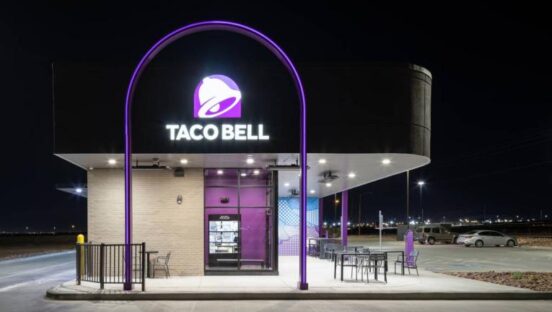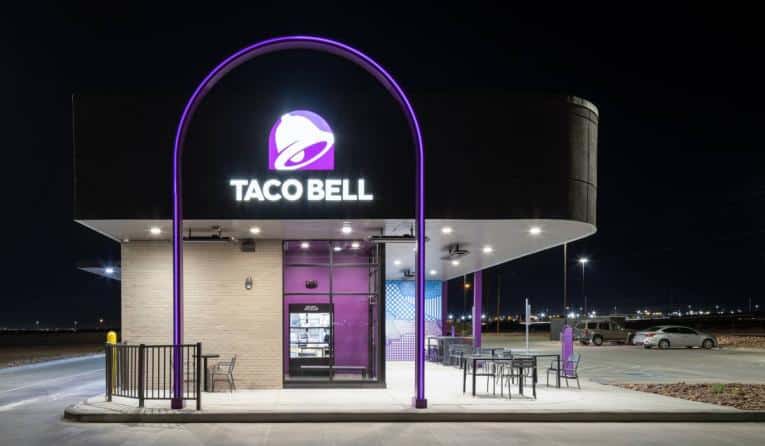For the third consecutive year, Taco Bell was the fastest quick-service drive-thru in America, according to the QSR Drive-Thru Report. This go-around, it clocked a total time of 278.84 seconds, a pretty sizable gap from Carl’s Jr.’s No. 2 result of 303.74. Taco Bell was also the pack leader in average service time at 205.35 seconds, ahead of Wendy’s 229.5.
From game-changing designs to BOH tech, it’s been a consistent and evolving journey for the Yum! Brands chain.
QSR caught up with chief development officer Matt Shaw to go behind the scenes of Taco Bell’s drive-thru success and where it all heads from here.
Let’s start with Taco Bell’s game-changing models in recent years. How is Defy coming along and what kind of learnings is the brand taking forward from that build?
Since opening its doors in June 2022, Taco Bell Defy has successfully decreased drive-thru wait times. This has created the opportunity to serve more customers and provide 2–3X the throughput of our standard restaurants thanks to an increase in ecommerce sales. And it’s not just fans who love the Taco Bell Defy experience, it’s team members too. Taco Bell Defy continues to maintain a steady application flow.
Despite being the most ambitious concept in Taco Bell’s history, the company is taking Taco Bell Defy’s learnings and exploring how we can integrate the successes into future builds. The restaurant was an industry wide lesson to embrace the digital age, and, at Taco Bell, we see this technology as a tool to interact with our fans.
How about the overall Go Mobile movement? In what ways does that continue to evolve?
In August 2020, we introduced the Go Mobile concept that enhances the digital and drive-thru experience for guests with additional access points. Since then, we’ve learned a lot. A few tools that we’ve seen work in our favor in the last three years are the fan access points via the Taco Bell Rewards loyalty program, the prototype’s ‘order ahead’ capabilities, curbside pick-up and expansion of drive-thru lanes. While Go Mobile is not the only contributor to success, the uptick of Rewards members visiting Go Mobile locations is certainly something we’re excited by.
The newest iteration of our Go Mobile movement is Taco Bell’s first small box design, with limited dining space and more digital touchpoints than any other Taco Bell restaurant currently. The first store of this next iteration opened in March in El Paso, Texas. The restaurant provides solutions for drive-thru bottlenecks created by the increase of mobile delivery orders and drive-thru popularity by eliminating the indoor dining area and adding dedicated parking for mobile or delivery orders, outdoor pick-up window, and grab-and-go shelves. The newest addition just opened in Columbus, Georgia and elements of these store will be incorporated into future builds.
More broadly, how has Taco Bell continued to innovate its drive-thru experience, from technology in the back to asset transformation? What are some key areas of focus right now?
We are focused on providing a seamless and easy experience for our team members and customers. We introduced our Touch Kitchen Display System (Touch KDS) in 2020 and it is now featured in most of our restaurants. This system gives our team members capabilities such as prioritizing orders based on size and complexity, easily accessing build cards, and sharing orders with other team members. Due to the ease of Touch KDS, we increased our efficiency and accuracy, which contributed to Taco Bell being named the fastest drive-thru for the past three years by you all at QSR magazine. The brand is continuing to roll out this system to most of its restaurants by the end of this year.
Have the metrics that define drive-thru success changed at all in recent years? Is speed of service still No. 1? Accuracy? What is the drive-thru consumer looking for in QSR now, and how has all the added competition from COVID forward raised the bar higher?
Customer and team member perception are the most important measures of success Taco Bell actively tracks when it comes to the drive-thru. Key indicators include things such as accuracy, hospitality and speed.
Our customers are digitally savvy, so we created digitally forward restaurants that simplify ordering and alleviate the increased drive-thru traffic. For example, we continue to experiment with dual drive-thru lanes that feature a mobile order lane, walk-up windows, grab-and-go shelves, dedicated mobile order and delivery parking, etc.
What are your thoughts on AI and its potential role at the drive-thru?
There are no updates on how Taco Bell will use AI, but we are excited to explore its possibilities.
How is Taco Bell connecting the omnichannel experience across the whole restaurant to alleviate some of the drive-thru capacity, and to give customers choice?
Taco Bell’s commitment to digital growth is paying off: digital sales grew almost 35 percent, year-over-year, in Q2 2023. As mentioned earlier, the newest iterations of Go Mobile help solve for an industry wide problem—drive-thru bottlenecks—and offer more digital touchpoints than our other restaurants. This gives our fans the ability to order through mobile and pick up their food at a walk-up window or at grab-and-go shelves, or they can use the traditional drive-thru lane. We are also integrating Touch KDS back-of-house technology to assist our team members, which increases speed of service and provides a more friendly work environment for all.









